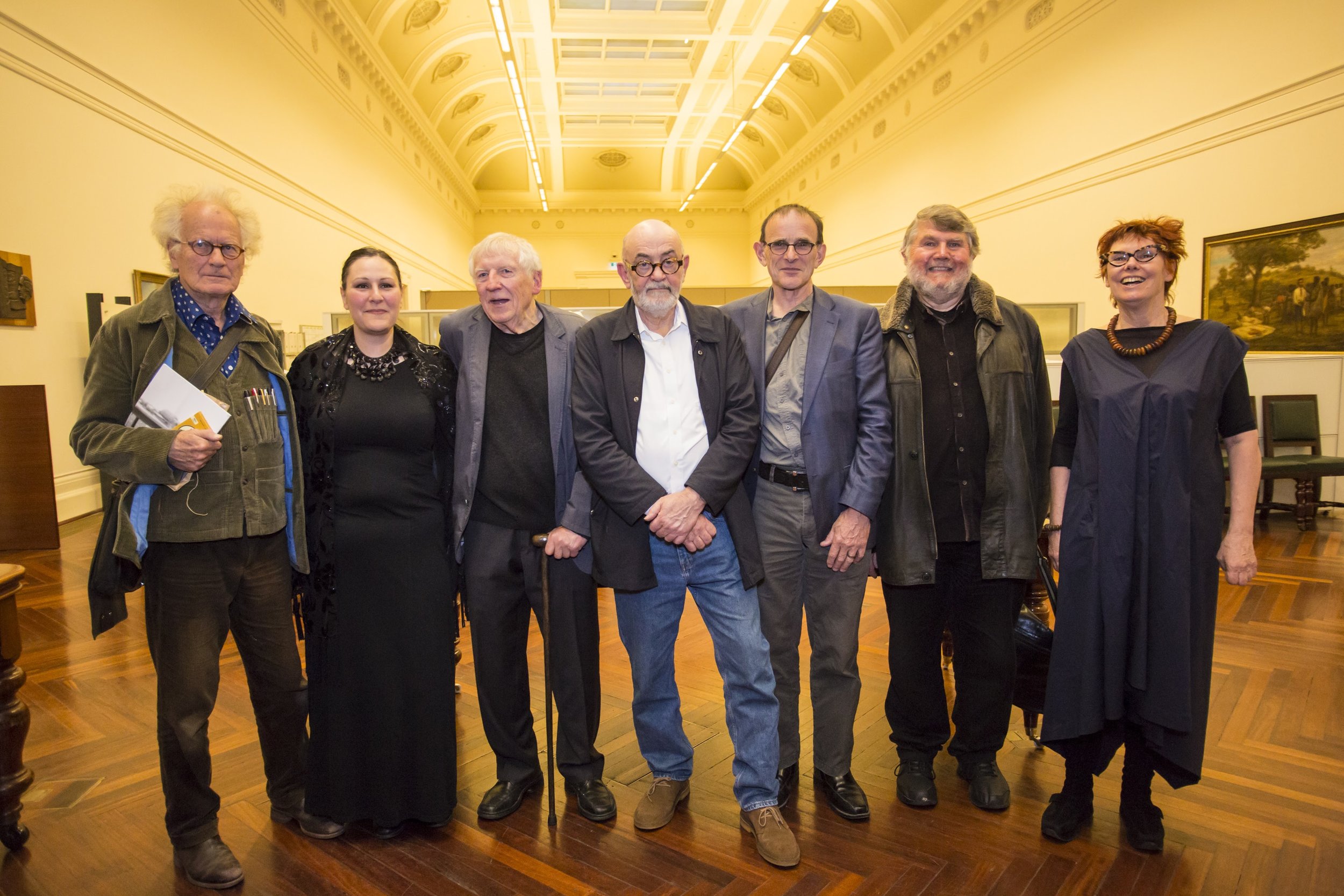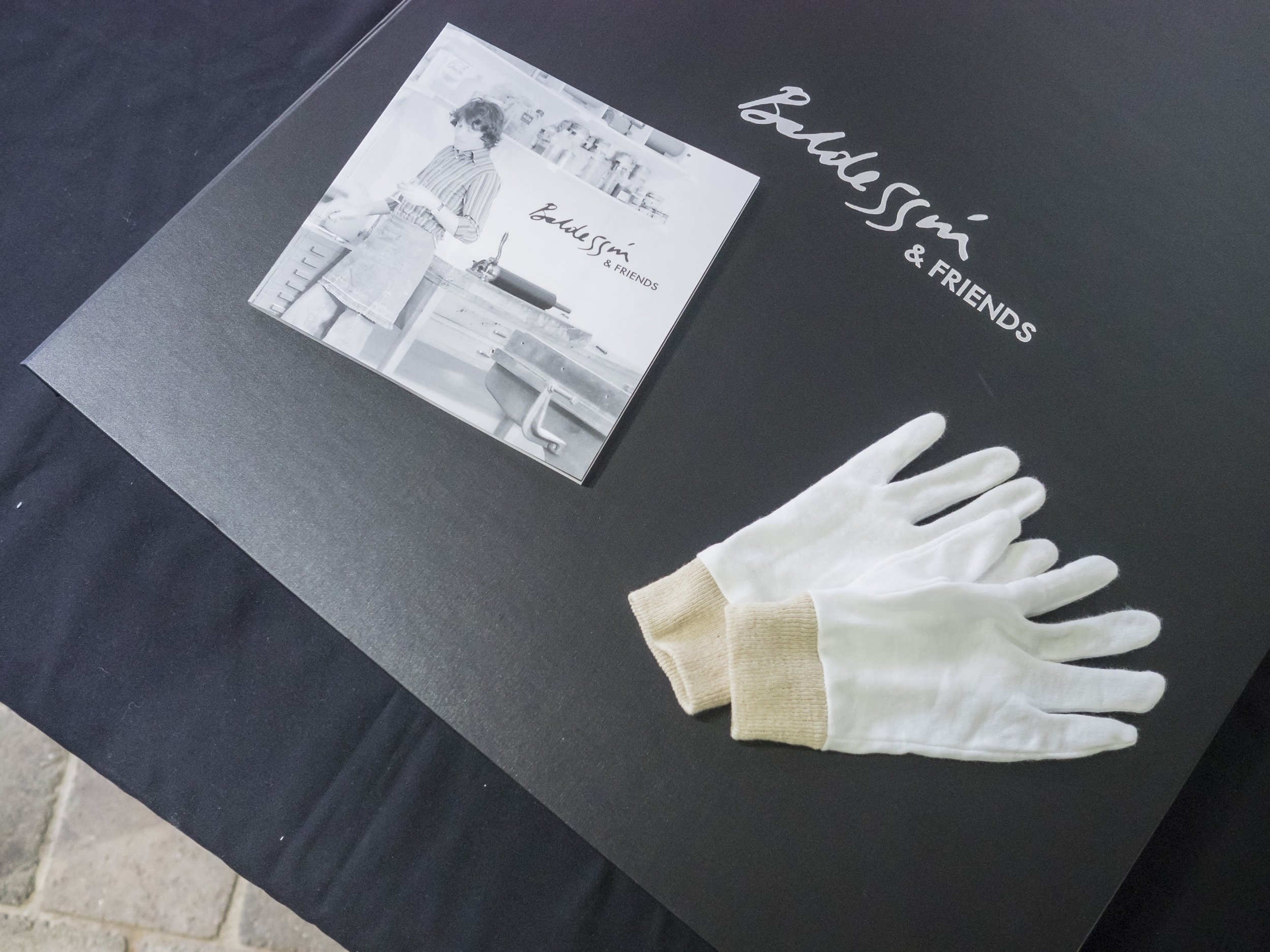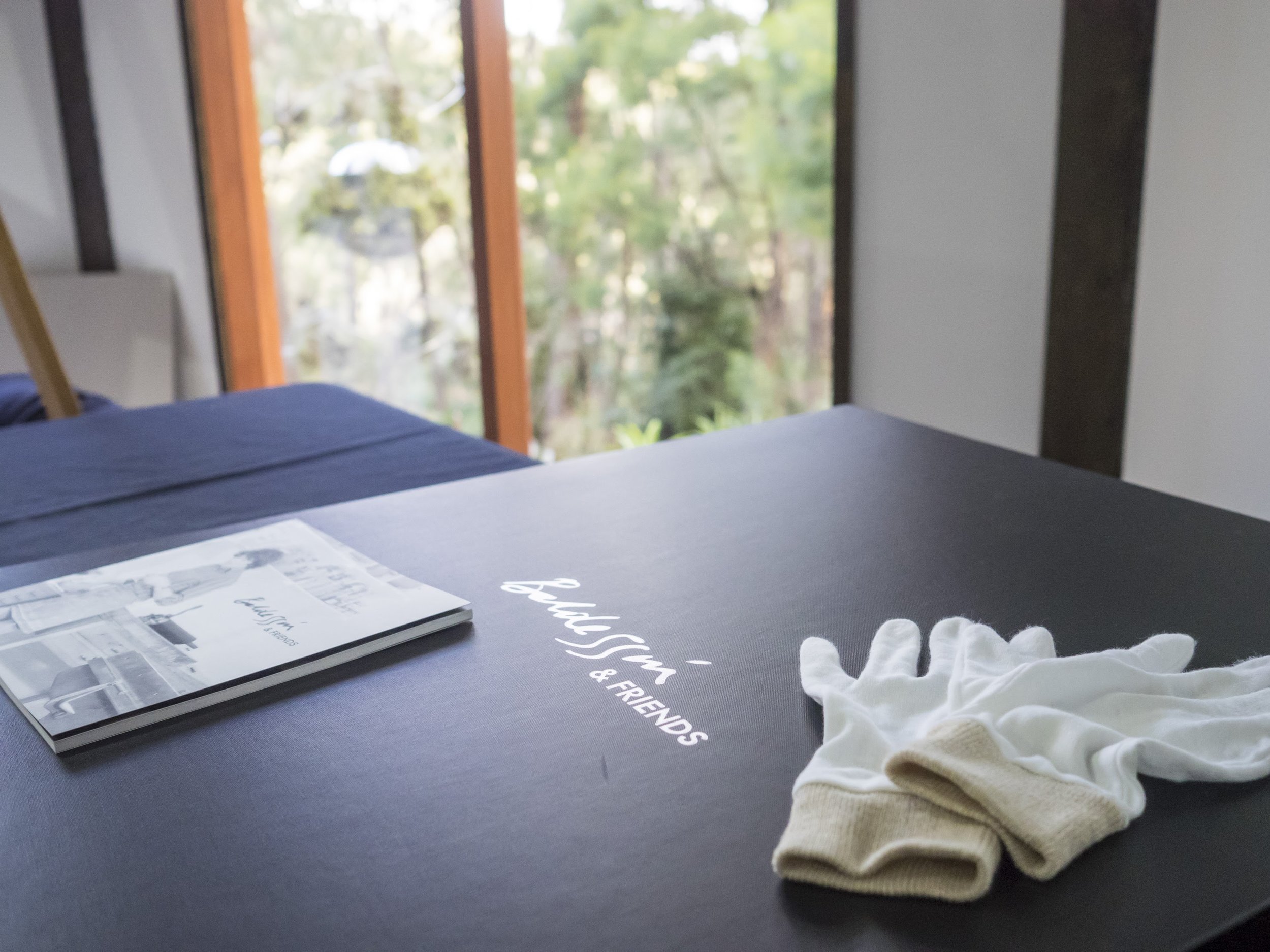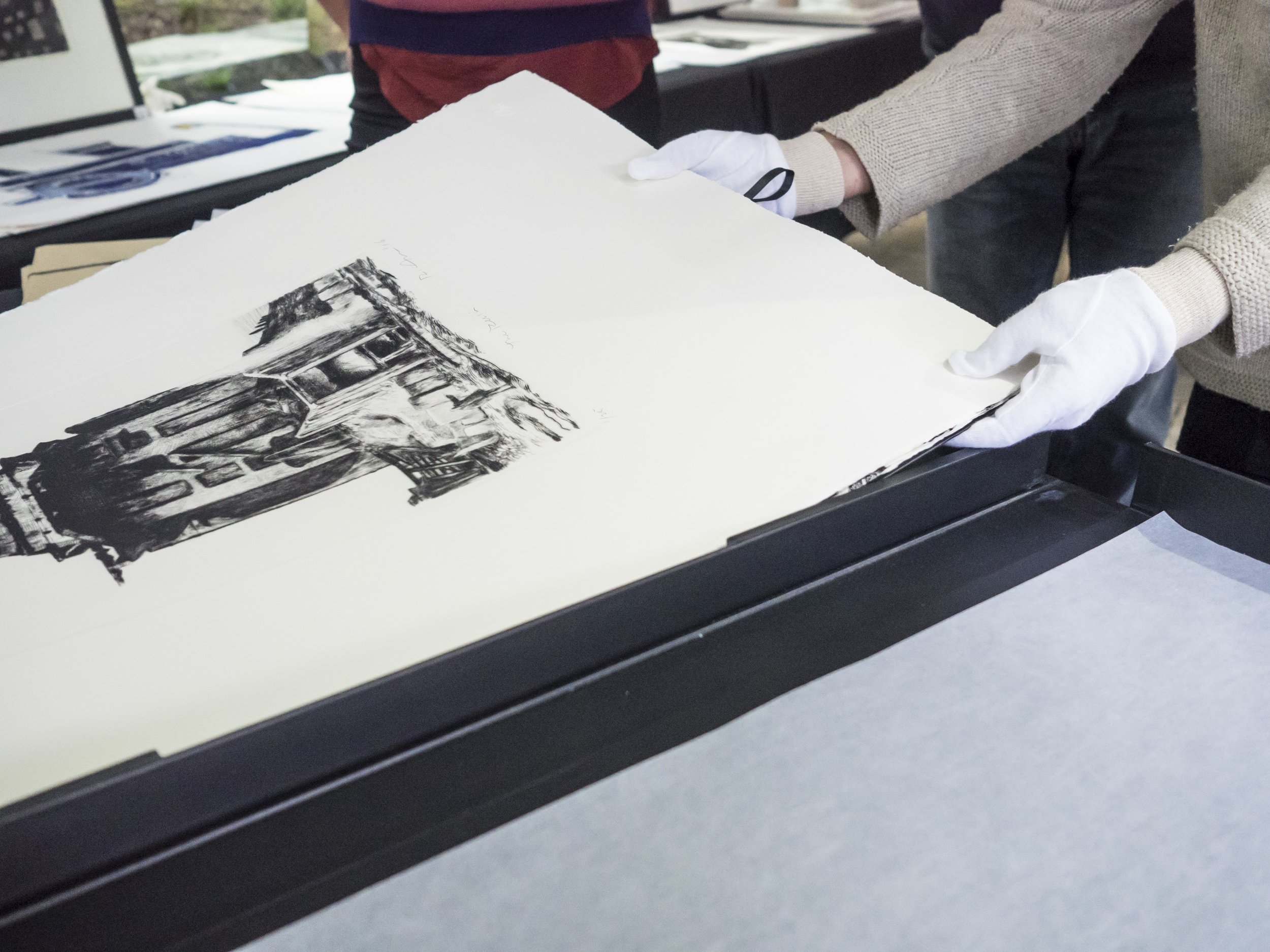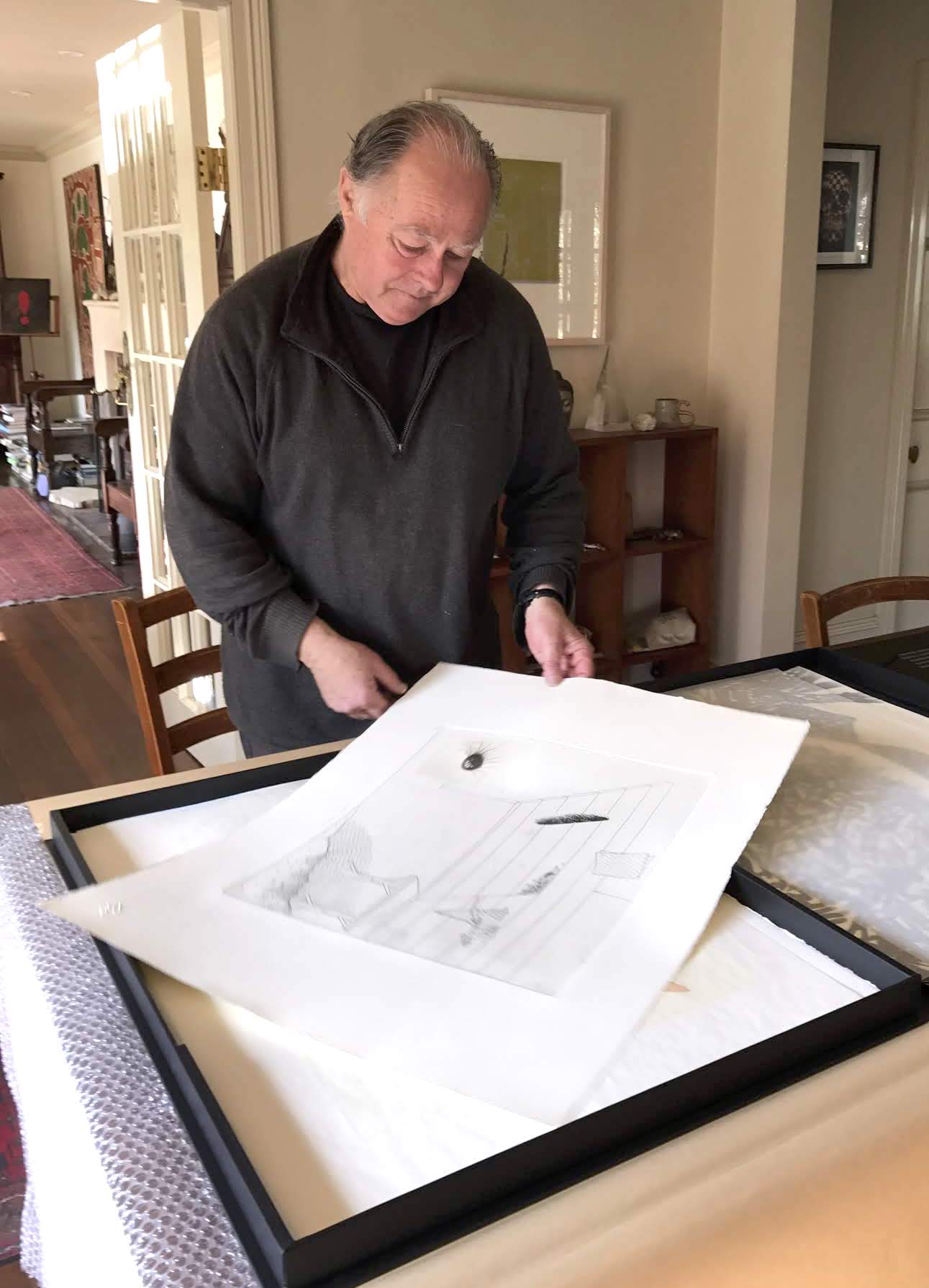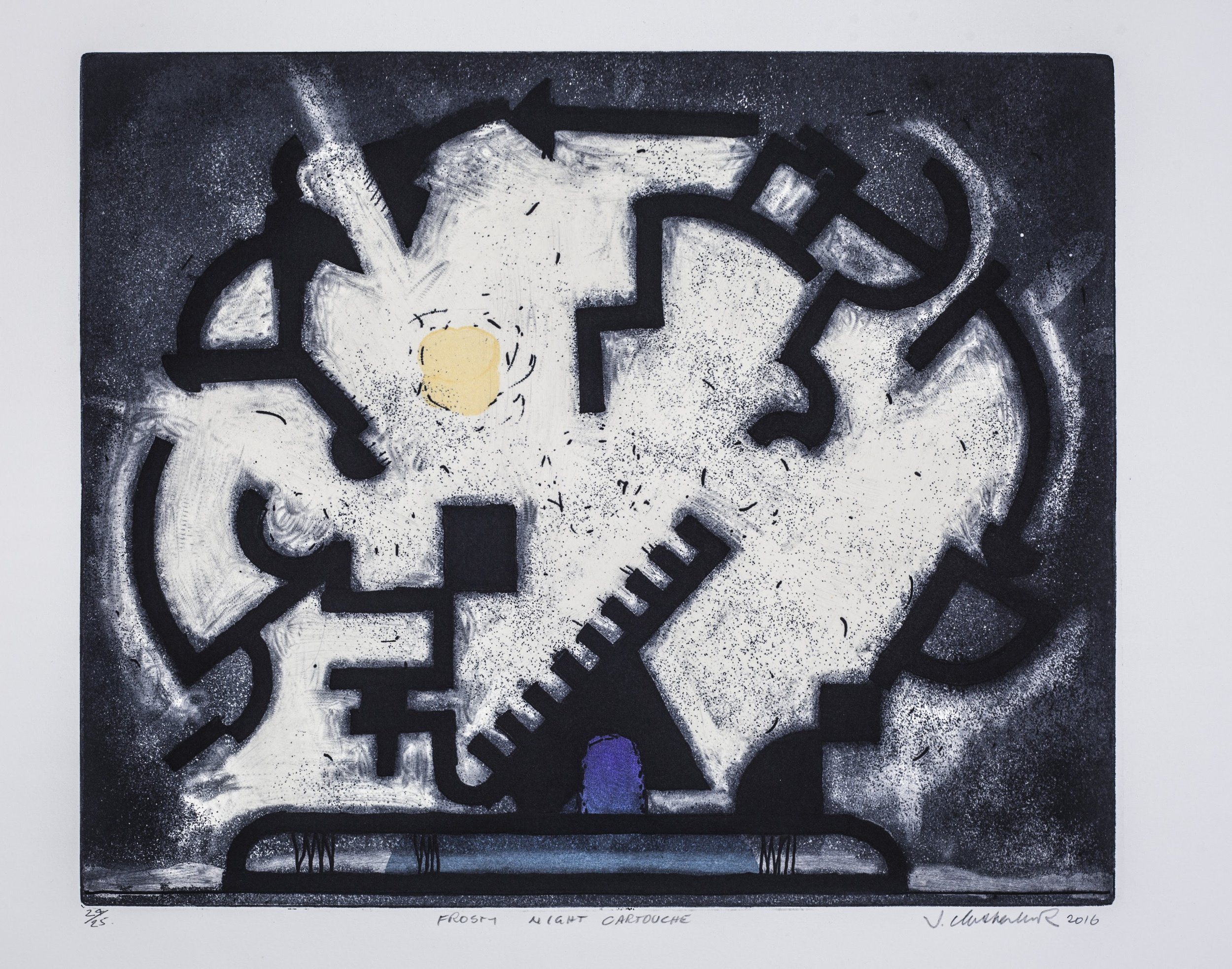The Baldessin & Friends commemorative folio celebrates the 15th anniversary of Baldessin Studio as a not-for-profit organisation, continuing the legacy of the renowned printmaker and sculptor George Baldessin (1939–1978).
The folio brings together seven celebrated Australian artists – Rick Amor, GW Bot, Jock Clutterbuck, Michael Leunig, Jan Senbergs, Imants Tillers and John Wolseley – all of whom share a personal connection to Baldessin, or to the Press itself. Each artist has generously created a new work specifically for this project and these are presented alongside the posthumous print, ‘Portrait II’, 1966, from the incomplete edition by George Baldessin. The collection is housed within a beautiful presentation box and are accompanied by an illustrated catalogue, with introduction by Professor Sasha Grishin.
From the edition of 25, 10 are available for sale.
All proceeds from the sale of the folio go directly to The Baldessin Press & Studio (a not-for-profit volunteer run organisation). This will allow the Press to perpetuate George’s generous and collaborative spirit, opening the studio and gardens to the public for creative use, as well as offering an expanded program of residencies, workshops, master classes, events and improved studio access.
PRINTS INCLUDED IN FOLIO
RICK AMOR
‘The Ruin’, 2016
Drypoint
Plate size 35 x 30 cm
Paper size 76 x 56 cm
George baldessin
‘Portrait II’, 1966
Etching and aquatint
Plate size 50 x 34.5 cm
Paper size 76 x 56 cm
IMANTS TILLERS
IN posthumous collaboration
with George Baldessin
‘Unsaid + Nameless’, 2016
Etching and photo polymer
Plate size 39 x 44.5 cm
Paper size 56 x 76 cm
JOHN WOLSELEY
‘Life world of the Longicorn beetle’, 2016
Woodcut from found log and etching on
chine-colle with watercolour
Plate size 36 x 30 cm
Paper size 76 x 56 cm
GW BOT
‘Baldessin Glyphs’, 2016
Linocut
Plate size 76 x 56 cm
Paper size 76 x 56 cm
MICHAEL LEUNiG
‘Pilgrim’, 2016
One colour etching
Plate size 51 x 41 cm
Paper size 76 x 56 cm
JOCK CLUTTERBUCK
‘Frosty Night Cartouche’, 2016
Etching with aquatint and colour stencil
Plate size 41 x 49.5 cm
Paper size 56 x 76 cm
JAN SENBERGS
‘New Jersey - rust belt’, 2016
Sugarlift etching
Plate size 56 x 76 cm
Paper size 56 x 76 cm
Contact us for more information: info@baldessinpress.com.au or Nicole: 0413 479 999
Baldessin & Friends folio - An essay by Emeritus Professor Sasha Grishin AM, FAHA
George Baldessin (1939-1978) died tragically young, at a time when he was working at the height of his powers and at the peak of his professional and popular acclaim. Yet what he achieved in his brief life was formidable and left a major impact on the art in this country for many decades to come.
George Victor Joseph Baldessin was born at San Biagio di Callalta, in the Veneto in Northern Italy on the 19th May 1939 and spent the first decade of his life largely separated from his parents. His father was drafted into Mussolini’s army, while his mother, who already had Australian citizenship, had gone back to Australia in the belief that her husband and son would soon follow. They did join her, but it was not for about ten years and the family was finally reunited in Melbourne in 1949. Baldessin was to conceal his Italian origins and enrolled as one of the ‘locals’ at the Royal Melbourne Technical College (RMIT). Here he studied between 1958 and 1961, while in the evenings working with his Italian uncle as a waiter at the fashionable Menzies Hotel. He majored in painting, but concentrated on sculpture under Lenton Parr and Vincas Jomantas, and then gravitated to printmaking under the newly appointed Tate Adams. In 1962 Baldessin travelled to Europe, first spending time in London at the Chelsea Art School, then visited Spain and subsequently studied at the Brera Academia in Milan, in the studio of Marino Marini, where Alik Cavaliere was a dominant presence.
Baldessin was back in Melbourne in July 1963 and started teaching, on a part-time basis, in the printmaking workshop at the RMIT. Sculptures and prints that he exhibited, from his first solo exhibition in 1964 until his death, were generally well received critically and were popular with curators from public art galleries and with private collectors. In 1975 he, and Imants Tillers, represented Australia at the Bienal de São Paulo, where he exhibited twenty-five silver laminate etchings titled Occasional Images from a City Chamber and a sculptural installation, Occasional Screens with Seating Arrangement. The mix of teaching plus his frenetic exhibiting activities, both nationally and internationally, marked his tragically short professional life that came to a sudden conclusion with his death in a car accident on 9 August 1978.
As a printmaker, Baldessin was not only a great master and innovator in technique, which inevitably all major artists are; he also created a new sensibility through his art. Many people seeing his work for the first time see it as tough, angst-ridden and disturbing, without appreciating the new sense of order and profound beauty that he created. In his prints, he combined a humanist preoccupation with the formal properties of abstract art – his displaced, dispossessed and alienated figures are flattened against the picture plane. He developed a repertoire of images, such as the highly abstracted and dismembered female figure, sometimes cantilevered across the picture space, who later is metamorphosed into the hairy Mary Magdalene, who plays both the role of the Biblical sinner and of M.M., the prostitute of the Rue St. Denis in Paris. These strange, self-conscious, tragic figures emerge as known actors who inhabit a familiar stage – a theatrical, surrealist stage, where factory chimneys appear like the smokestacks of gas chambers, where there are odd non-functional tables and chairs, banquets for no eating and strange fruit, including his unlikely pears, which inhabit the space.
Provocative and endlessly inventive, these etchings curiously embrace you as you melt into the created space. There is edginess in his art, an endless ambiguity and a seductive sexuality. The imagery, with its collection of emblems and fragmented torsos, draws on numerous sources, including the early etchings of Fred Williams, Shiko Munakata’s woodblocks, the films of Ingmar Bergman and Luis Buñel and the art of Alik Cavaliere, but ultimately the synthesis is unique to Baldessin. Like very few Australian artists, he created a style and artistic language which is immediately and recognisably his own.
How can one best pay homage to George Baldessin, the printmaker? His widow, Tess Baldessin, in 2001 set up a not-for-profit organisation, The Baldessin Press & Studio, to celebrate and continue in a tangible way the artist’s legacy. To mark the fifteenth anniversary of its foundation, seven significant Australian artist printmakers were invited to create a print for a commemorative portfolio. Also included in the portfolio is a posthumous etching with aquatint by Baldessin, Portrait II (1966), which was printed from the artist’s plate by Deanna Hitti. The seven invited artists are – Rick Amor, GW Bot, Jock Clutterbuck, Michael Leunig, Jan Senbergs, Imants Tillers and John Wolseley – each in his or her own way pays homage to the master.
Rick Amor is one of Australia’s most distinguished senior artists and has created a drypoint etching, The ruin (2016), in the tradition of Piranesi, where a traveller points to a crumbling edifice to emphasise the transience of life and the triumph of time. The aphorism that comes to mind, is the one ascribed to Hippocrates and best remembered in the Latin version: ‘Ars longa, vita brevis, occasio praeceps, experimentum periculosum, iudicium difficile’ (one possible rendering is: Art is eternal, while life is short, the opportunity fleeting, the experiment dangerous and the judgement harsh). This could serve as a comment on an artist’s endeavour in general and on Baldessin’s life in particular. In Amor’s homage the ruin presents a stage-like space in which Baldessin’s personages once performed.
GW Bot is a Canberra-based artist who accepted Baldessin’s challenge for every artist to create their own and distinctive language that is universally accessible, yet remains true of their time and place. In her linocut, Baldessin’s Glyphs (2016) she implements her specially devised language of glyphs to celebrate the triumph of life over the forces of darkness. Each glyph has been derived from hundreds of sketches taken from nature that have been distilled into this powerful and expressive element. The elements have been assembled into a narrative where the forces of the red sun float effortlessly in the picture space.
Jock Clutterbuck overlapped with Baldessin when he studied sculpture and printmaking at the RMIT between 1965 and 1966. His commemorative print, Frosty night cartouche (2016), an etching combining aquatint and colour stencil, is complex and sophisticated, but also possesses a lucidity and simplicity. A cartouche, as is frequently encountered in Clutterbuck’s art, is a form encountered in Egyptian hieroglyphs, where the oval shape has a horizontal line at one end, and the contents within the oval frequently bear a reference to royalty. Within this cartouche, purple and light ochre squares establish an uneasy harmony.
Michael Leunig, or simply Leunig as he is universally known, is one of Australia’s ‘living treasures’ and profound cultural commentators. His etching Pilgrim (2016) is a meditation on a person’s passage through life, where each of us is a pilgrim and touches the earth lightly. Leunig’s etching has a floating lightness and a whimsical humour reminding us that you can make a serious comment and at the same time carry a little bit of humour with you.
Jan Senbergs is Baldessin’s exact contemporary. He was also born in Europe and was forced by war to flee his homeland, arriving in Melbourne in 1950. He also worked at the RMIT and in 1973 represented Australia at the Bienal de São Paulo. Senbergs’ sugarlift etching, New Jersey – rust belt (2016), may find its origins in the time he spent at Harvard in America in 1989-90, but in the context of Baldessin, it explores an industrial urban surreal vision that was common to both artists. Although there is a sense of grandeur in Senbergs’ monumental forms, the scale is deceptive with the image bled to the full-size of the sheet of paper like a microcosm of a much bigger whole.
Imants Tillers and Baldessin met on their way to the Bienal de São Paulo in 1975 and in the following year worked on two collaborative etching plates in Paris that were printed by Pierre Giarudon. Tillers’ commemorative etching is titled Unsaid + Nameless (2016) and subtitled “In posthumous collaboration with George Baldessin”. Here he brings into this imaginative collaboration Redon’s iconic spider with floating surrealist elements harking back to his experiences with Baldessin in Paris exactly forty years ago. It is a poignant image of absence that can be read in the tradition of the memento mori.
John Wolseley is the final artist in this collaborative portfolio and presents a challenging and intriguing print Life world of the Longicorn beetle (2016). Technically it is one of the most challenging prints in the portfolio, where he has printed directly from a design encountered on a found log to which he has added an etching on chine-collé, giving the print a silky surface, and this has been supplemented with watercolour. The Longicorn beetle attacks the eucalypt and in the process of tunnelling into the wood of the tree leaves scribbly patterns. In Wolseley’s print, the beetle has become an active artistic collaborator and the print itself could be viewed as a worldview or an account of an ecosystem from the beetle’s perspective.
Henry Miller, writing on D.H. Lawrence, once observed: "The only way to do justice to a man like him [Lawrence] who gave so much, is to give another creation. Nor explain him, but prove by writing about him that one has caught the flame he tried to pass on." All seven artists included in this portfolio through their prints proclaim that they honour Baldessin and that they have caught the flame and now will carry the torch.
Emeritus Professor Sasha Grishin AM, FAHA
Australian National University
Contact us for more information: info@baldessinpress.com.au or Nicole: 0413 479 999

